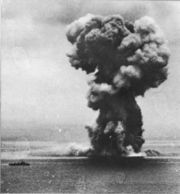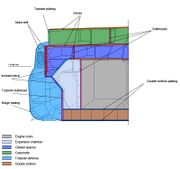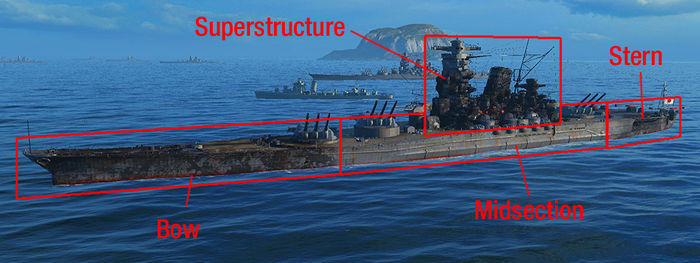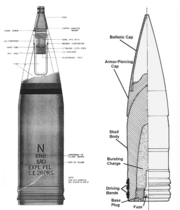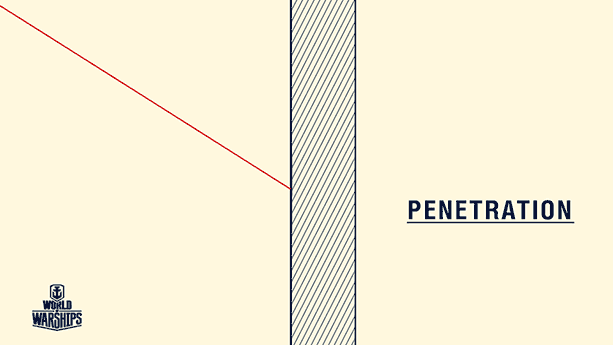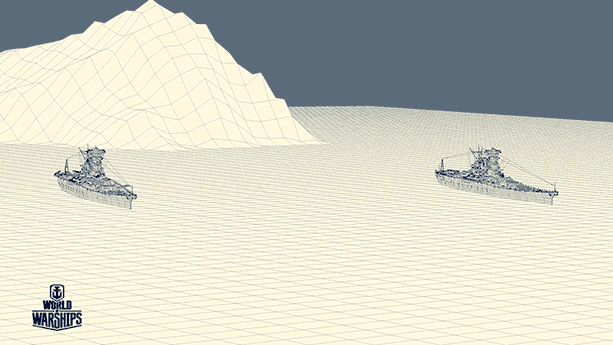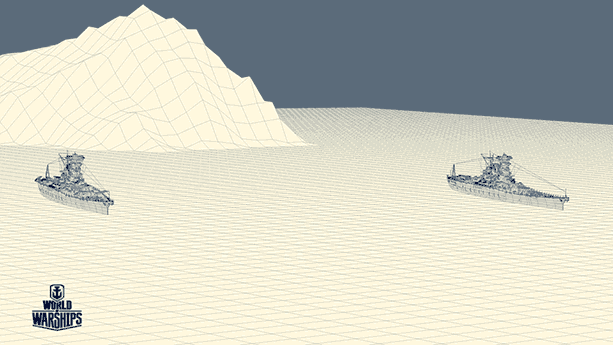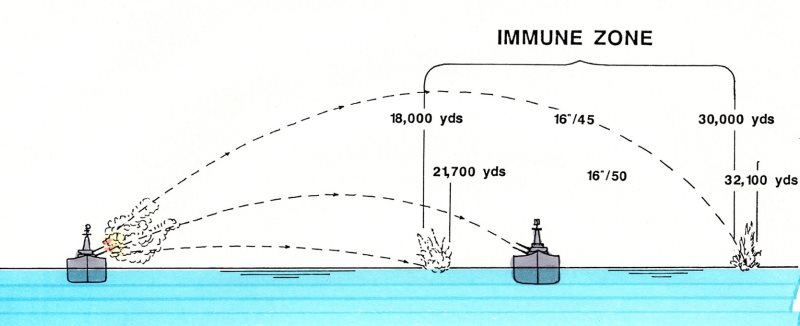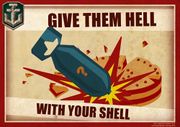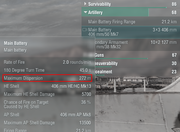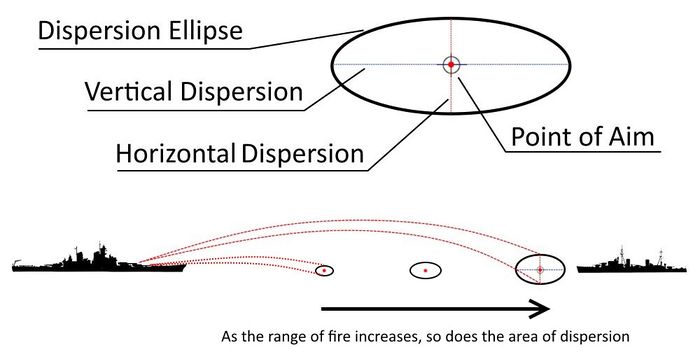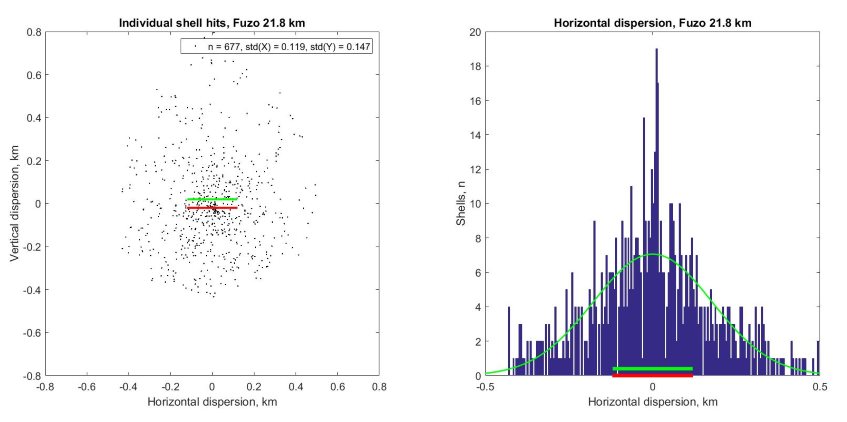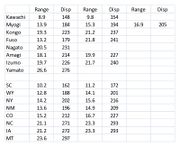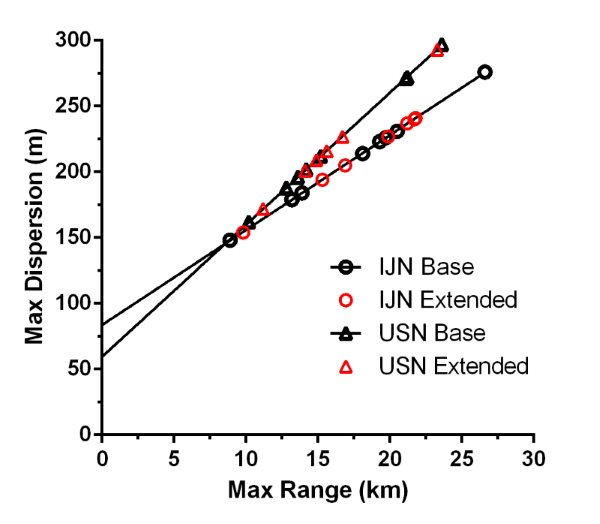Geschütze und Panzerung
Inhaltsverzeichnis
Panzerung und Unterteilung
Panzerung
Die Panzerung in World of Warships ist keine einheitliche Schicht, die man durchdringen kann (wie in World of Tanks), sondern eher wie ein vielschichtiger "Kuchen" der verschiedene Bauteile und Mechanismen schützt, von denen jedes eine spezifische Panzerungsanordnung hat. Eine Granate, die in ein Schiff eindring, kann bis zu vier oder fünf Schichten durchdringen oder an einer von ihnen abprallen. Entsprechend zielen die Entwickler bei den Schiffsmodellen darauf ab, die Panzerung der historischen Vorbilder Schicht für Schicht nachzubilden. Panzerung ist natürlich sehr schwer: Bei einem normalen Schlachtschiff macht sie rund 40 Prozent der Gesamtmasse aus. Daher versuchten die Schiffskonstrukteure mitunter, Gewicht zu sparen, indem sie nur die wichtigsten Teile mit Panzerung schützten wie die Magazine und Treibstoffbunker, die Maschinenräume, die Feuerleitanlage sowie die Kommando- und Kommunikationszentren. Die meisten der anderen Bereiche sind oft fast ungeschützt. Dieses Konzept, manche Schiffsteile komplett zu schützen, andere dagegen praktisch gar nicht, wird als "all or nothing" (alles oder nichts) bezeichnet. Man nimmt also in Kauf, dass das Schiff bei Beschuss durch kleine und mittlere Kaliber in den ungepanzerten Abteilungen mehr Schaden nimmt, um die wichtigsten Bereiche besser vor großkalibrigem Beschuss zu schützen.
Die wichtigsten Bereiche des Schiffs werden von der Zitadelle umschlossen, die man sich wie ein nach oben geschlossenes, unten offenes, rechteckiges Floß mit angeschrägten Seitenwänden innerhalb des Schiffsrumpfs vorstellen kann. Einerseits war es erstrebenswert, die Zitadelle möglichst klein zu halten, doch andererseits bildete der umschlossene Bereich zugleich eine wichtige Auftriebsreserve, um bei einem Wassereinbruch in anderen Abteilungen den Untergang des Schiffs zu verhindern. Im Spiel wird das ganze Schiff zerstört, wenn es gelingt, sämtliche Hitpoints der Zitadelle zu zerstören, selbst wenn keine andere Abteilung beschädigt wurde.
Von der Zitadelle aus führen Schächte nach oben zum Kommandoturm und zu den Geschütztürmen. Letztere werden als Geschützbänke (eng. barbettes) bezeichnet. Die Magazine befinden sich innerhalb oder neben den Geschützbänken. Hier werden die Granaten für die Hauptgeschütze sowie das Treibmittel gelagert. Durchschlägt auch nur einziger Treffer die Zitadellen-Panzerung im Bereich eines Magazins, kommt es oft zur sofortigen Vernichtung des Ziels durch eine spektakuläre Explosion.
Woher können Spieler wissen, wo sich diese wichtigen Abteile befinden, wenn sie auf die Flanke eines unbekannten Schiffs zielen? Auch ohne die Konstruktionspläne des Schiffs zu studieren - was im Hafen des Spiels durchaus möglich ist - kann man dazu begründete Vermutungen anstellen. In der Regel liegt die Zitadelle mehr oder minder in der Mitte und ist etwa halb so lang wie das Schiff insgesamt. Als Daumenregel sollte man also mittschiffs knapp oberhalb der Wasserlinie auf den Bereich unterhalb der Schornsteine anhalten, wenn man ein Schiff von der Seite unter Beschuss nimmt. Die Magazine befinden sich in der Regel direkt unter den Geschütztürmen der Hauptbatterie. Läuft das Ziel auf das eigene Schiff zu oder von ihm weg, zielt man knapp unter den Bug beziehungsweise unter das Achterschiff. Treffer am Bug prallen allerdings häufig ab.
Über den seitlichen Panzergürtel hinaus, der vor direktem Beschuss schützt, weisen Schlachtschiffe zudem eine Deckpanzerung gegen aus großer Entfernung abgefeuerte Granaten auf, die fast senkrecht von oben einschlagen (Steilfeuer). Aufgrund der großen zu schützenden Fläche fällt die Deckpanzerung von Schlachtschiffen jedoch wesentlich dünner aus als der Panzergürtel. Entsprechend kann es gelingen, die Deckpanzerung auch mit Granaten zu durchschlagen, die für den Panzergürtel zu schwach wären.
Abschottung
Ein Kampfschiff bildet eine Kombination aus einem Kampffahrzeug und einer Militärbasis - es ist darauf ausgelegt, über längere Zeiträume hinweg eigenständig zu operieren. Entsprechend wird ein erheblicher Teil des Raums in einem solchen Schiff für alltägliche Aktivitäten benötigt, hat aber im Gefecht keine unmittelbaren Auswirkungen auf seine Kampfkraft. Zerstört eine Granate bei einem Schusswechsel die Waschküche oder Kombüse, beeinträchtigt das die unmittelbare Kampfkraft weit weniger als ein Treffer in einem Magazin oder im Maschinenraum.
Aus diesem Grund sind die Schiffe im Gegensatz zu den Fahrzeugen in "World of Tanks" in mehrere verschiedene Abteilungen mit einer jeweils unterschiedlichen Anzahl Trefferpunkten (eng. hitpoints, HP) unterteilt. Grob gesagt sind es die folgenden: Bug, Heck, Zitadelle, Kasematte (der restliche mittlere Rumpfbereich ohne die Zitadelle) und die Aufbauten. Zusammen haben alle diese Abteilungen etwa doppelt so viele Trefferpunkte wie der nominelle Gesamtwert des Schiffs (effektive Kampfkraft): Im echten Leben wäre das Schiff längst außer Gefecht, lange bevor wirklich jeder einzelne Teil zerstört ist.
Jede dieser Abteilungen außer der Zitadelle hat zwei Grenzwerte, nach deren Überschreiten der Schaden bei weiteren Treffern gedämpft wird. Diese Grenzwerte unterscheiden sich von Abteilung zu Abteilung.
- Anfangs erleidet das Schiff Schaden gemäß des normalen Algorithmus (Faktor 0,33 beim Durchschlag einer Granate). Außen wird die anfangs saubere Abteilung von Treffer zu Treffer immer dunkler.
- Nach dem ersten Grenzwert wird der weitere Schaden halbiert (Faktor 0,165 beim Durchschlag einer Granate). In dieser Phase ist die Abteilung von außen ganz schwarz.
- Sobald schließlich der zweite Grenzwert überschritten wird, erleidet die Abteilung keinen weiteren Schaden. Auch das Aussehen verändert sich nicht weiter. Der Angreifer bemerkt nur, dass seine Granaten in diesem Bereich des Ziels nichts mehr bewirken.
- Unabhängig vom Zustand einer Abteilung führen glatte Durchschüsse (eng. over-penetration) stets zu Schaden mit Faktor 0,1 und Treffer in der Zitadelle immer zum vollen Schaden (Faktor 1,0), auch wenn alle Trefferpunkte der entsprechenden Abteilung bereits aufgebraucht sind.
- Wird mittschiffs der zweite Grenzwert erreicht, dann nehmen fortan alle weiteren Abteilungen nur noch Schaden wie nach ihrem ersten Grenzwert, selbst wenn sie bis dahin noch gar nicht beschädigt worden waren. Schaden aus Feuer, Wassereinbruch, Durchschüssen oder Treffern in der Zitadelle wird nicht von den Trefferpunkten der einzelnen Abteilungen abgezogen, sondern ganz regulär von der Gesamtzahl Trefferpunkte des Schiffs. Auch vollständig zerstörte Abteilungen, die keine eigenen Trefferpunkte mehr haben, können also nach wie vor ganz normal brennen oder Wassereinbrüche erleiden und dadurch das Schiff als Ganzes beschädigen.
Modules
There are multiple modules in-game: engine, propeller, anti-air emplacements, torpedo tubes, main caliber turrets, etc. The modules have three states: functioning, damaged, and destroyed. A damaged module loses function until it is repaired, a destroyed module cannot regain function. Some modules can only be damaged but not destroyed (e.g. propeller), other modules can only be destroyed but not damaged (e.g. AA emplacements).
Each module has a certain amount of HP. Every time that module is damaged, the game calculates a probability of it being damaged (that probability can be lowered by 34% with a tier 5 commander skill). The probability of a critical hit that leads to damage increases for lower module HP values. Once the module reaches zero HP, it is destroyed.
Shell Types
World of Warships currently has two types of shells:
- High-explosive (HE)
- Armor-piercing (AP)
The ballistic models for AP and HE shells are identical. Shell's in-game tracer may not coincide with the actual trajectory, in order to better visualize the shooting process.
High-Explosive
These shells have an instant fuze, and burst immediately upon hitting a target. HE shells, like AP shells, do 1/3 of the max damage that is displayed in-port upon penetration, and full HE damage is awarded for citadel penetrations. Non-penetrating hits deal no damage. Although they have a certain armor penetration capability, equal to about 1/6 of shell's diameter — or 1/4 of a shell's diameter for German battleships and cruisers — rounded normally. The resulting value must be greater by 1mm than the armor to be penetrated. One shouldn't try to penetrate heavy armor with these shells. Naturally, hitting citadels of certain lightly armored cruisers and carriers with HE is fair game. Instead, HE shells are best used for knocking out modules, such as anti-aircraft emplacements, and starting fires, which can deal a large amount of damage over time.
Inertia Fuze for HE Shells
Inertia Fuze for HE Shells is a level 4 Commander Skill which increases the armor penetration of an HE shell by 30%. The mechanics for penetration are calculated as follows:
(Gun caliber /4 [German battleships and cruisers] or /6 [all other ships]) x1.3, subject to normal rounding.
e.g.: Atlanta, (127/6)x1.3=27.516_ rounded to 28, can penetrate 27mm of armor with HE shells and the Inertia Fuze for HE Shells skill chosen for her captain. Admiral Hipper, (203/4)x1.3=65.975 rounded to 66, can penetrate 65mm of armor with HE shells and the Inertia Fuze for HE Shells skill chosen for her captain.
Armor-Piercing
Unlike HE, the AP shell does damage only if it penetrates the armor. The fuze of the AP shell is initiated after it passes through armor, and historically the fuze times were calculated in a way that would allow the shell to explode after traveling about ten or so meters after passing through the armor; that way the shell exploded around the middle of the battleship. That means that when AP shells are fired at lightly armored and relatively small target, they might over-penetrate -- explode once they passed through the entire ship, or not even explode, if the shell doesn't encounter enough armor to activate the fuze. Let's illustrate the fuzing concept with the Iowa's AP Mark 8 16 inch projectile. Its Mark 21 Base Detonating Fuze (BDF) had a delay of 0.033 seconds. Fuze activation requires a resistance equal to 1.5 inches (3.8 cm) of armor at 0 degrees obliquity or 0.375 inches (1 cm) at 65 degrees obliquity. The muzzle velocity for a new gun and a full charge is 762 meters per second. Therefore, if the shell were to immediately hit an armor plate 1.5 inches thick after exiting the barrel, it would explode 762*0.033 = 25 meters after passing through that armor plate. Most AP shells in game have a fuzing time of 0.033 seconds, but there are shells with as much as 0.1 second fuzing time. As of patch 0.3.1, the armor thickness necessary for AP shell fuzing was as follows (caliber - armor): 410mm - 68mm, 356mm - 59mm, 203mm - 34mm, 155mm - 26mm.
Non-penetrations (bounce/ricochet) will always deal 0 damage, regardless of AP or HE (the latter cannot ricochet). However, HE shells still has a chance to start fires or break modules with its splash damage). The angles for AP ricochets are as follows:
- 0-30 degrees -> auto ricochet (0-22.5 for USN 8" shells)
- 30-45 degrees -> chance to ricochet (22.5-30 for USN 8" shells)
- 45-90 degrees -> ricochet doesn't occur (30-90 for USN 8" shells)
Penetrations deal x0.33 of the shell's listed damage. Whether AP or HE, it must penetrate the armor and detonate inside the ship. Over-penetrations deal x0.10 of the shell's listed damage. Over-penetration is when a shell penetrates the ship through-and-through, before it has a chance to detonate inside the ship. Theoretically HE will never over-penetrate due to its low detonator threshold and shorter fuze. Citadel hits will always deal x1.0 of the shell's listed damage (though citadel over-penetration is still possible, and will only deal x0.10 damage). It is impossible to get a citadel hit on a destroyer, as they no longer have them per se (it was removed in 0.2.4/0.3.0). Prior to 0.4.1, penetrations on a destroyer's midsection will deal x0.5 of the shell's listed damage (in lieu of the absence of citadels), however this is no longer the case and penetrations to it will deal the standard x0.33 of the shell's listed damage.
Properly angling the ship matters a great deal when the enemy is shooting AP shells: when an AP shell encounters armor at an angle, it has to pass a greater amount of armor for penetration. Additionally, at certain critical angle (below ~20-40°), the shell will simply ricochet, even if it might have ad enough armor penetration. A shell may still cause damage after the ricochet, but only to the same ship. If the armor thickness is less than 1/14.3 of shell's caliber, a ricochet does not occur regardless of armor encounter angle.
There are certain engagement ranges when AP shells will encounter both the belt and the deck armor at fairly large angles, and will have a high probability of either non-penetration or ricochets. The distance at which both plunging fire and direct enemy fire is less effective is called the immunity zone (IZ). Despite the absolutist nature of its name, the immunity zone concept does not imply any sort of invulnerability. A ship fighting within its IZ will still probably suffer when hit, but it is theoretically proof against singularly catastrophic hits to the citadel. (plunging-fire still need more testing, the issue with the capped ranges causing the shells were benefit from it being "auto-bounce" against deck armor)
AP shells can penetrate ship's armor even below the waterline, after traveling through water. The illustration to the right depicts a typical underwater trajectory of an AP shell: (1) - shell enters the water and is fuzed due to rapid deceleration (2) - trajectory angle changed (this happens every time an AP shell hits water) (3) - after a short delay, the fuze explodes the shell. The image also demonstrates two outcomes of an underwater hit: armor penetration, and a ricochet. As of 0.4.1 the underwater hits do not cause flooding.
Secondary Guns
As a general rule, secondary guns fire HE rounds, with the exception of the IJN 140mm, 152mm, and 155mm guns, which fire AP. Secondaries fire only when an entire enemy ship is visible; if the enemy is partially obscured by an island the secondaries will not fire.
Choosing Between AP and HE Shells
Some general guidelines for each of the three ship classes:
As a Battleship
Shooting other battleships with AP is most effective with direct fire at point-blank and medium ranges, roughly up to ~10-12 kilometers. The enemy battleship shouldn't be at too great of an angle; ideally, it should be perpendicular to your line of fire. You might also get some citadel hits with plunging fire at maximum fire ranges. If you aren't positive that you have a good chance of penetrating the citadel, HE shells are a better choice.
AP shells should be used against well-armored cruisers and carriers as well, when you are certain that a volley at the waterline will penetrate the citadel. Since their armor thickness will be nowhere near that of a battleship, angling will affect your AP shells to a lesser degree. It might be a good idea to light a carrier on fire first, though, to prevent it from launching aircraft
Against lightly-armored cruisers and carriers, you should be using HE shells -- they have enough armor penetration to damage citadels. However, some carriers have enough armor to resist HE, and AP should be shot at them. You should also use HE against destroyers -- AP shells would almost always over-penetrate; and besides HE shells will knock out multiple modules on a DD, making it easy prey after a few hits.
One last thing: it's better to use the shell of the wrong type (e.g. AP against a destroyer that suddenly materialized near your ship) than to start a long half-minute reload. Sub-optimal damage is better than no damage at all.
Cruisers
Against battleships your best bet is HE shells. Consistent HE hits and nonstop fires are a bane of many battleship drivers' existence. However, don't try to fight a battleship single-handily; a skilled BB driver can dispatch you in a few well-aimed AP salvos. At point-blank ranges and favorable angles you can also try to penetrate the battleship's citadel with AP shells, though it's generally not a good idea to be that close to a battleship in the first place.
Against other cruisers and carriers use AP shells at close and medium ranges, when you can reliably hit the citadel: a well-aimed salvo remove as much as half of the other cruiser's HP. If the cruiser is far away, or is angling too much, use HE; HE should also be used against the destroyers in practically all situations.
Destroyers
Your main weapon is a torpedo, especially if you're driving an IJN DD. However, HE shells can still be very useful when fighting other destroyers, or providing additional fire against enemy capital ships -- in the latter case, your shells won't be doing much damage, but you can make up for that with the sheer number of shells, and fires. AP shells can sometimes be used against lightly armored enemy cruisers, since you have just enough armor penetration to defeat their citadel armor.
Shell Dispersion
However perfectly a naval gun on a stationary ship may be laying, successive rounds will not impact on a single point but will fall in a pattern scattered both in deflection and in range. This phenomenon is called dispersion and, irrespective of human and constant error, it is caused by multiple inherent factors: minor variations in the weight of the projectile, differences in the rate of ignition of the propellant, variations in the temperature of the bore from round to round, physical limitations of precision in setting values of deflection and quadrant elevation on the respective scales, minor variations in wind, air density or air pressure, and so on.
Observing the position of the surface bursts around our point of aim, we find that they fall into a roughly elliptical area in relation to the line of fire. An ellipse constructed around the dispersion area is called the dispersion ellipse. Every time a player orders his main caliber guns to fire, the game engine constructs a 2-D ellipse around the point of aim, and does so independently for each salvo fired. A double-click will fire all guns in one salvo with one dispersion ellipse, sequential fire will construct dispersion ellipse for each turret salvo separately. This ellipse has a certain length and width values, which are dependent on the characteristics of the gun. The dispersion value displayed in port is the horizontal length of the dispersion ellipse at the maximum fire range, i.e. a value that describes the lateral distribution of the shells relative to the player's ship.
Shell impacts within the dispersion ellipse are not uniformly distributed over the surface, but lie more thickly towards the center of aim. The intensity with which the shells fall in different points of the area of dispersion, can be described by a Gaussian (normal) distribution. The in-port value describes dispersion in terms of one probable error, i.e. it gives a value where 50% of the fired shells will land around the point of aim. This has been confirmed by experiments conducted by the players. Port dispersion value (red bar in the graph below) is the standard deviation (green bar) of shell hits across the horizontal axis of the dispersion ellipse:
If the shooting distance is below the maximum range, the horizontal dispersion value decreases accordingly. Horizontal dispersion values at distances other than maximum firing range, as well as the vertical dispersion values have not been made public by WarGaming. However, based on the user collected data for some ship they are as follows:
data will be added later
Dispersion values are same for HE and AP shells of the same gun. The player's gun dispersion value can be modified by player's equipment and by enemy's camouflage. Gun Fire Control System Modification 2 decreases the area of the shell dispersion ellipse by 7%. Additionally, WarGaming has indicated that not acquiring the target with the X button increases dispersion by an unspecified amount.
If all base and maximum dispersion values for battleships are plotted, two distinct linear trends emerge: one for IJN, and another for the USN tree:
Curiously, one could hypothesize that battleship dispersion at ranges below maximum also follows this linear pattern. For example, even though WG does not disclose Iowa's dispersion at 10 kilometers, by looking at this graph we can estimate it to be around 150 meters, etc. If that is correct, then all IJN battleships have superior accuracy to their USN brethren at ranges above ~10 kilometers, and vice versa.
For patch 0.4.1, WG has decreased the close-range (i.e. below 4km) dispersion values for all ships.
